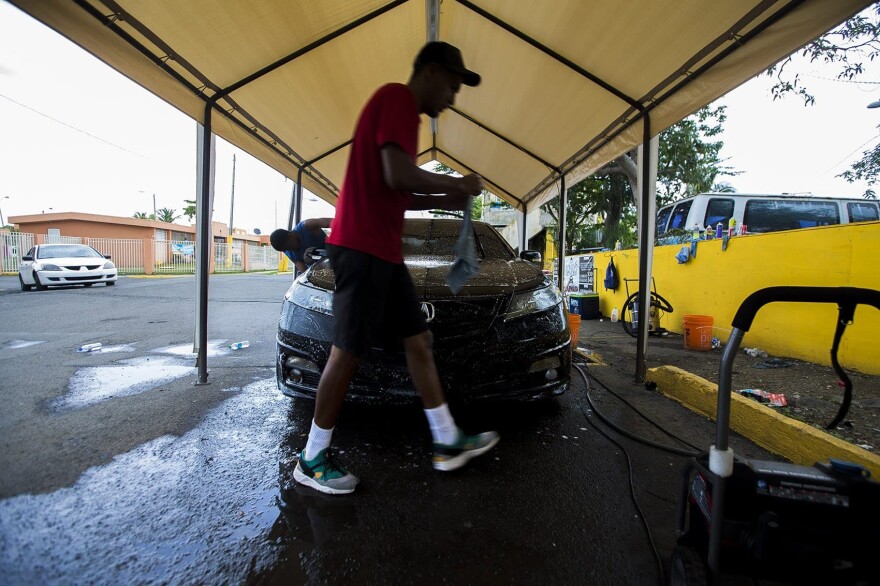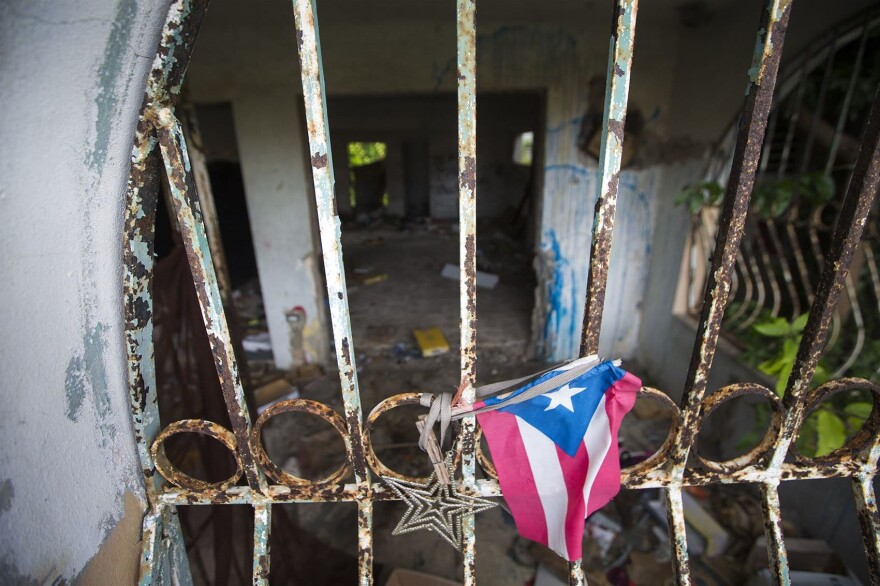In the outskirts of San Juan, far from the gleaming towers downtown, there’s a makeshift car wash on the side of the road. Young men spray down a beaming black Acura — a starkly clean machine in a neighborhood struggling to return to normality a year after Hurricane Maria.
This car wash didn’t exist before the storm. It’s one of many realities people on the island describe as “before Maria” or “after Maria.”
Angel Rosario is a resident of the neighborhood, Bravos de Boston, in an area called Peninsula de Canteras. He spent much of his childhood in Springfield, Massachusetts; in the wake of Hurricane Hugo, he was sent to live with his grandmother in the late 1980s. And like all Puerto Ricans, who are U.S. citizens from birth, Rosario had the chance to return to Springfield when Maria hit.
“But I decided to stay here … seven months without energy,” he says. “Nobody came. No government help. The help came from all the people, all the neighbors. … We helped each other.”
Rosario says two of his neighbors died after the hurricane. One of them he had to bring to the hospital in a car, and she died on the way.
‘Almost All Of My Children Have Left’
It’s a Saturday afternoon in Bravos de Boston, and there’s not a child in sight. Like many places across Puerto Rico, the barrio feels quieter these days than it should.
The neighborhood is a microcosm of an island that’s yet to shake the devastation of the Category 5 hurricane that struck a year ago this week.
Experts warn the flight of Puerto Ricans to the mainland United States, from before and after Maria, could threaten the commonwealth’s recovery.
Rosario says worse than having no power was having no job. He says before the hurricane he was an athletics director for the public housing authority in San Juan.
He and many of his neighbors lost their jobs after the storm, and he says many left the neighborhood to look for better conditions in places like Massachusetts.
He points to the absences in each of the homes around his own: “In this house, she left, the one from the second floor, she left too — one, two, three, six families, just in this street.”
A few old men drink beer in the middle of the road Rosario lives on. Cuban son music thumps from a pair of speakers on a construction site where Jose “Canito” Contreras is rebuilding his home.
Contreras is among the ones who stayed in Bravos de Boston. After being rejected by FEMA in his initial application for recovery money, Contreras says he won on appeal and got the maximum allocation from the agency — $33,300. He says it’s an enormous help, but with the price of building materials skyrocketing after the storm, it only goes so far.
“To see the house as it was, and then to see it demolished, that was hard,” he says. “That was hard. But I’ve had faith all along that things will return to normal.”
With the help of one of his sons, Contreras says he hopes to be finished in time for Christmas, when the neighborhood plans to celebrate together — a new tradition “after Maria.”
“Almost all of my children have left,” Contreras says in a matter-of-fact voice. “They left after the hurricane. They left because they have their own children — and because of everything they were lacking: no electricity, the mosquitoes, everything.”
To make matters worse, the government shut down the neighborhood public school.
An Exodus Amid An Exodus
Across San Juan, outside the gleaming architectural marvel of the Puerto Rico Convention Center, a row of riot police stand guard. The island’s fiscal control board is having one of its regular meetings, and there’s been rumors a protest could break out.
Inside the building, economist José Caraballo-Cueto looks out a window, down at the line of police. He tells me why people are upset with the organization set up to manage the finances of the Puerto Rican state while it looks for a way out of a debt crisis.
“There’s a lot of people that [are] not happy with the imposition of the fiscal control board,” he says. “And more than imposition, the policies that they are taking, the austerity. … After Hurricane Maria, they are giving even more money to bondholders than to social spending in Puerto Rico.”
Caraballo-Cueto heads the Census Information Center at the University of Puerto Rico in Cayey. He describes Puerto Rico as being in the midst of a “great depression” — a recent report from the center claims Puerto Rico is the third-most unequal country on Earth, behind South Africa and Zambia — and he notes that hundreds of thousands of islanders had left in the years leading up to the storm.
Federal data show 179,000 more fled after the hurricane. Many have returned, but Caraballo-Cueto estimates 77,000 have not. And he says those are exactly the people Puerto Rico needs to help with the reconstruction.
“Most of the people that are migrating from the beginning of the great depression are young people, and this is causing an increase … in the percentage of older population in the island,” he says. “Right now Puerto Rico is the oldest country in the Americas.”
Now the big question is what will happen with the tens of billions in federal disaster money set to roll into Puerto Rico.
Caraballo-Cueto says it’s a crucial point in the island’s history. If the recovery windfall is spent wisely, it could create long-term employment for those who want to stay and work here.
That way, more people like Canito Contreras can contribute to the reconstruction.
With an angle grinder close at hand, Contreras says in spite of everything that’s happened he feels positive about the future. And besides, he says he owes to his daughter — who has a severe disability — to rebuild their lives on the island they call home.
“My daughter is the one who inspires me,” Contreras says, before returning to his cinder blocks.





Copyright 2018 WBUR


